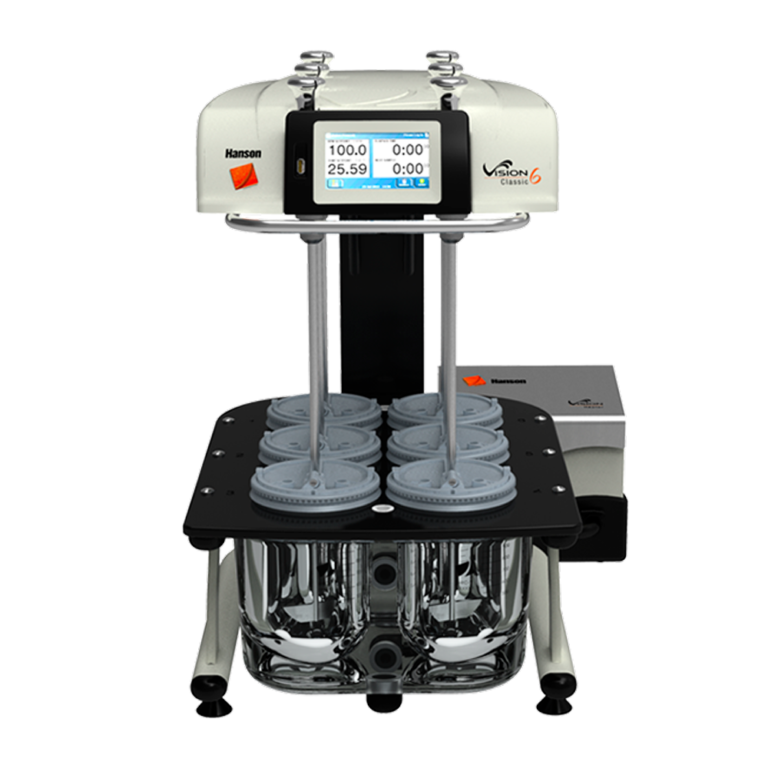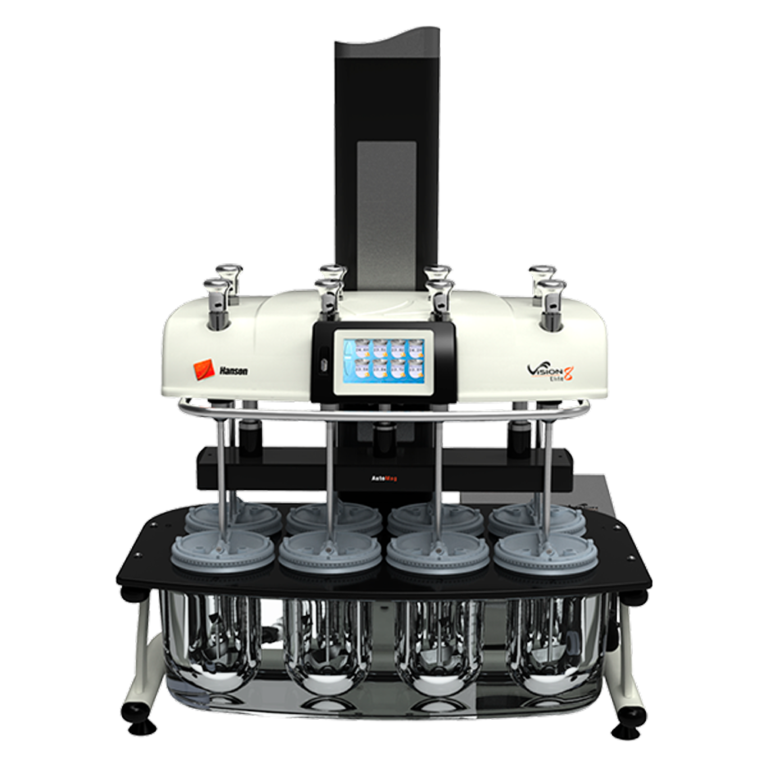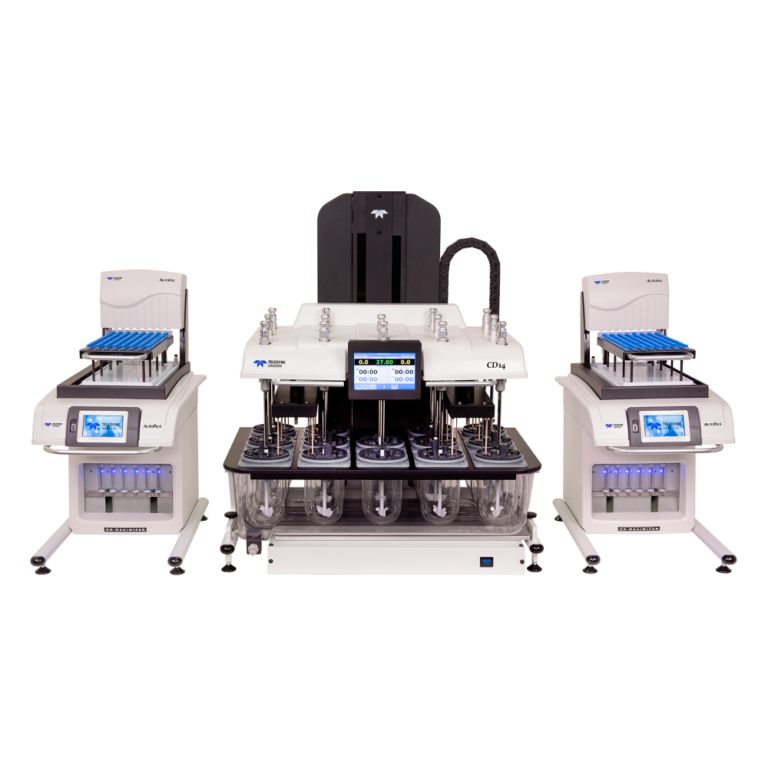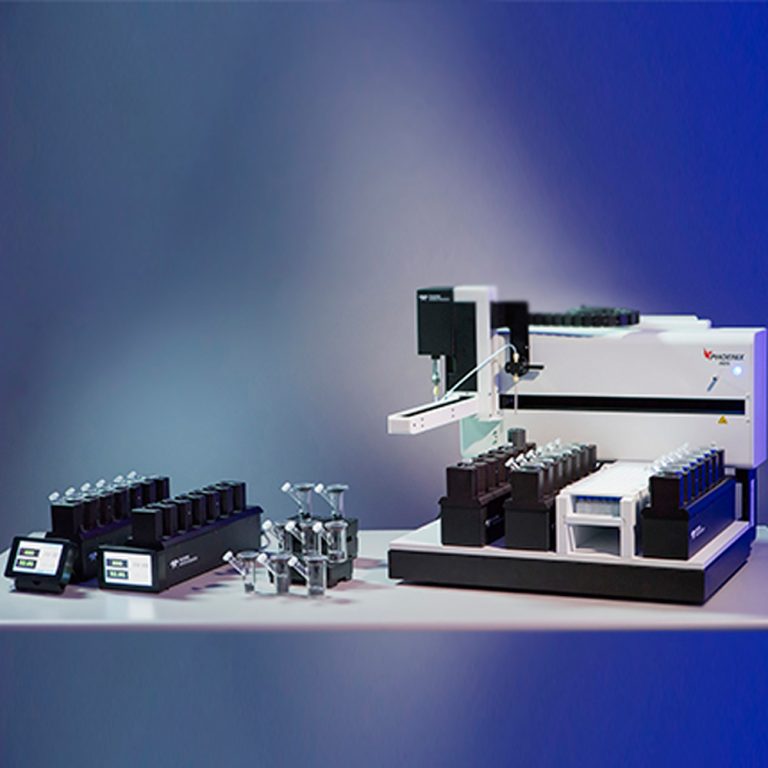
TELEDYNE HANSON RESEARCH
VISION® G2 CLASSIC 6
The Vision G2 Classic 6 dissolution tester is the compact, rugged workhorse sibling to the Vision G2 Elite 8. Named in honor of the world’s first dissolution tester, a six-position test station introduced by Hanson Research in 1969, the G2 Classic 6 is precision engineered to ease the rigors of manual dissolution testing. The G2 Classic 6 meets and exceeds worldwide standards including compliance with USP, FDA, ASTM, EP, JP, CE, CSA, RoHS, and 21 CFR Part 11. FEATURES ▪ Award-winning design (2 across x 3 deep) provides easy access to all vessels ▪ Compact footprint saves valuable bench space ▪ 6-position Easi-LockTM vessel plate ensures proper vessel centering ▪ Up to 100 protocols stored (create, manage, call routines) ▪ Superior coating protects vessel plate from corrosion ▪ Fixed drive head guarantees repeatable, drive head positioning ▪ No tools or adjustments needed to switch among USP App. 1, 2, 5, 6, and 150 mL and 250 mL small volumes ▪ “Quick Test” feature begins tests immediately with the push of a button ▪ Adaptable for automated sampling

TELEDYNE HANSON RESEARCH
VISION® G2 ELITE 8
The Vision G2 Elite 8 dissolution tester is a versatile performance machine, built with the highest quality components and engineering. The G2 Elite 8’s ergonomic design and workhorse performance make it ideal for automation and extended applications as well as for 8-sample manual testing. The G2 Elite 8 meets and exceeds worldwide standards including compliance with USP, US FDA, ASTM, EP, JP, CE, CSA, RoHS, and 21 CFR Part 11. VISION G2 DISSOLUTION TESTING Vision G2 dissolution testers are designed with over 60 years of dissolution expertise and know-how. The modular design is plug-and-play ready making these systems upgradeable or automated without the need for separate firmware. They come standard with a full color touchscreen and intuitive menus, giving users the confidence of precision control for speeds 25-250 rpm and temperature 25-55 °C. Powerful programming, backed by a robust security system for 25 users, features the ability to create up to 100 unique protocols that can be conveniently transferred by flash drive to other Vision G2 testers, resulting in higher throughput and sample analysis.

TELEDYNE HANSON RESEARCH
CD14 COMPARATIVE DISSOLUTION
The Teledyne Hanson 14-vessel CD14 Comparative Dissolution Tester runs two methods simultaneously or independently—ideal for bioequivalence studies of generic vs. innovator drug formulations. The 14 stirring positions allow for 6+1 or 12+2 configurations for improved workload efficiency in R&D, formulations, QC, and stability-test labs. With digital temperature probes at 12 positions the CD14 comparative dissolution tester is able to test two different formulations with separate settings for every parameter under the same temperature conditions. FAST, POWERFUL COMPUTER CONTROL The CD14 is controlled by a fast, powerful computer built into the color touch screen display mounted to the drive head. The adjustable tilt angle accommodates operators of different heights while the Linux-based operating system with its own SQL database responds instantly to user input. The highly durable resistive touch screen works with gloves on or off. An easy-to-use interface includes context-sensitive help; logs for events, errors, test reports, test history, and service; rapid programming of new methods; ability to search database by any combination of fields; import/export including full system backup; programmable alarms for automatic power-on and warm-up; countdown to sampling points; tools including full system diagnostics; and more. CD14 FEATURES AND BENEFITS ▪ The CD14 provides the smallest footprint in the 14-vessel class: 85 cm W x 61 cm D. Precision vessel centering system exceeds the most demanding enhanced mechanical specifications. ▪ Store up to 500 protocols (methods) on-board. ▪ Run two different 6 vessel methods simultaneously or one 12-vessel method. ▪ Rugged water bath with low-position front port for ease of draining. ▪ Heater/circulator slides out for ease of servicing. ▪ Large color touch screen with adjustable tilt angle for operators of different heights. ▪ Compatible with Apparatus 1, 2, 5, and 6. ▪ Spindle speed: 25 rpm to 250 rpm, accurate to ± 1 rpm with displayed resolution 0.1 rpm. ▪ Temperature: programmable from 25.0 °C to 50.0 °C with accuracy of ± 0.5 °C. ▪ Digital temperature probes: 10 °C to 60 °C with accuracy of ± 0.1 °C from 30 °C to 55 °C, and displayed resolution of 0.01 °C. ▪ Compliant with USP, EP, JP, US FDA Enhanced Mechanical Calibration and ASTM E2503 standards. ▪ Seamless integration with CD AutoPlusTM autosamplers and AutoFillTM fraction collectors. 21 CFR PART 11 COMPLIANCE The CD14 onboard database stores up to 100 users with three levels of security (operators, managers, and administrators) with the ability to customize permissions and profiles at each level. The CD14 biometric fingerprint reader allows rapid enrollment of one or two fingers and provides positive ID of instrument operators. A password-only option is also included. Customize your own report formats and approval systems by specifying up to three signatures per report. An extensive audit trail records all system events and logs any changes made by users. System configurations are stored on-board and the system logs any changes to methods and configurations. SERIALIZED COMPONENTS All critical components of the CD14 are identified by unique serial numbers traceable to the factory level including the spin-shafts installed into the drive head, all baskets and paddles, and all dissolution vessels. The part number and serial number of each vessel are laser-engraved into the top of the vessel rim in large, easy-to-read type, such that breakage of the glass will not destroy identifying information. The on-board database of the CD14 stores the system configuration including the serial numbers of all vessels, paddles, and baskets, and the position into which each item is installed. PRECISION VESSEL CENTERING SYSTEM Each dissolution vessel installs into an adjustable bracket attached to the vessel plate. These vessel-centering brackets allow precision adjustments to the dissolution vessel’s position in relation to the spin-shaft and any apparatus attached to it. The system allows fast and easy vessel centering to meet or exceed USP and/or ASTM mechanical calibration specifications. CD AUTOPLUS AND AUTOFILL The CD AutoPlusTM autosampler is designed to work with the CD14 Comparative Dissolution tester. The CD AutoPlus comes with 6 sampling channels, and DissoScanTM or MaximizerTM configurations. Precision syringe pump mechanics, all-inert tubing and valves, and color touchscreen programming with up to 100 protocols are standard on each instrument. The AutoFillTM is a precision fraction collector fully compatible with all AutoPlus autosampler models.

TELEDYNE HANSON RESEARCH
PHOENIX DRY HEAT SYSTEMS
The new PhoenixTM dry heat diffusion testing systems from Teledyne Hanson Research provide manual and automated instruments that are more compact, easier to use, and more precise than conventional systems. The Phoenix family of products includes an advanced cell design, a six‐cell manual sampling system with a compact footprint, and an automated sampling system capable of testing up to 24 diffusion cells at once. The Phoenix DB-6 and Phoenix RDS systems and their components are protected under U.S. patent 10,753,841. PHOENIXTM DRY HEAT DIFFUSION CELLS The new PhoenixTM Dry Heat Diffusion Cell is designed for precision, versatility, and ease‐of‐use in diffusion‐testing labs. In manual sampling applications, the wide opening in the arm accommodates standard pipette tips. For maximum versatility, lab analysts can choose from small, medium, or large borosilicate glass cells and, using special volume‐adjustment mixer/inserts, can obtain receptor media volumes from 10 mL to 30 mL. An array of cell cap kits accommodates all 25 mm membranes, orifice diameters from 9 mm to 20 mm, and dosage volumes from 0.25 mL to 6.2 mL. A convenient fill mark on the sampling arm indicates the cell is filled. Phoenix cells are easily inserted and removed from the heating block. Cell preparation, including dosage application, bubble detection, and bubble removal, is fast and easy. PHOENIX DB‐6 MANUAL DIFFUSION SYSTEMS The Phoenix DB‐6 dry heat diffusion system provides a compact footprint for six‐cell testing. Precision heating and stirring systems contained within the block makes the system fully portable, able to be placed in any position the analyst chooses for faster, easier cell preparation. With precise control of mixing speeds from 200 rpm to 900 rpm, and temperatures from 25 °C to 40 °C, the system meets or exceeds USP <1724> specifications. An advanced color touch screen running on an embedded single‐board computer with a built‐in SQL database and real‐time clock provides advanced monitoring, diagnostic, and reporting capabilities, user‐friendly programming and navigation, storage for up to 100 test protocols, and configurable security for up to 50 users. The large, bright display allows key parameters to be seen from a distance, including speed, temperature, elapsed time, and time to next sample. When sampling is due, the system alerts the operator with the cell position, a countdown timer, and an audible beep. Test reports are delivered via the Teledyne Hanson serial validation printer. PHOENIX RDS AUTOMATED DIFFUSION TESTING The Phoenix RDS Robotic Diffusion Station refines the art of diffusion testing by incorporating Teledyne Hanson’s breakthroughs in four areas: diffusion cell design; heating and stirring; automated sampling and collection; and computerized control. The dry heat diffusion cell at the heart of the system delivers significantly improved test results as compared to traditional water‐jacketed, displacement‐sampling systems. The precision heating and stirring components built into each of the six‐cell blocks provide outstanding control of temperature and speed. Automatic sampling and collection are accomplished through a syringe driven probe on an XYZ platform controlled by Teledyne Hanson’s sophisticated Diffusion Master software. The automated system mimics the way sampling, collection, and media replace are performed by laboratory analysts when working manually, while simultaneously reducing the potential for variances due to procedural inconsistencies. The modular design of the six‐cell dry‐heat block allows laboratories to move smoothly between manual and automated methods when scaling to higher numbers of experiments. BUILD YOUR OWN PHOENIX DIFFUSION TESTING SYSTEM The Build Your Own System tool is an interactive way to explore the capabilities of Teledyne Hanson’s diffusion-cell-testing platform known as Phoenix Dry Heat Systems. The configurator will automatically guide you through the steps required to build your own diffusion cell testing system. It will ask you to choose between manual or automated sampling; various cell sizes and mixer-insert combinations to achieve specific receptor media volumes; choices of cell cap kits having different donor chamber volumes and membrane exposed areas (orifice diameters); and so on. It is recommended to first review the configurator instructions. If you have already reviewed the instructions, you can go directly to the “Build Your Own Phoenix Diffusion Testing System” configurator page.

RainPhil, Inc. was established and incorporated in July 25, 2000. Our company is one of the trusted suppliers for Laboratory Equipment Apparatus for Biomedical and Life Science use in the Philippines.
TELEDYNE HANSON
14-Vessel CD14
8-Vessel Elite 8
6-Vessel Classic 6
Phoenix Dry Heat Systems
BMG LABTECH
PHERAstar FSX
CLARIOstar Plus
Omega Series
SPECTROstaar Nano
Contact
Frequently Asked Questions
Inquire Now